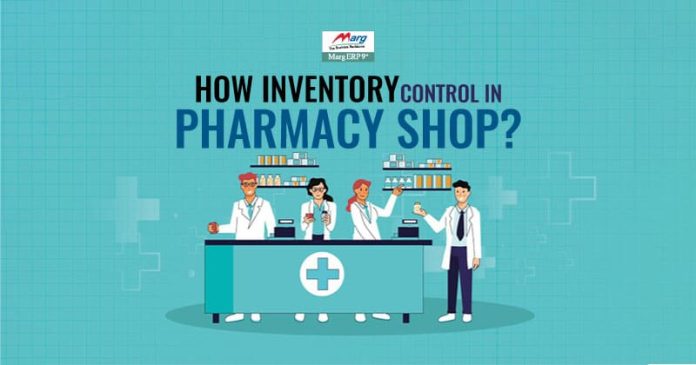Managing inventory well is very important for any pharmacy shop. Good pharmacy inventory management ensures that medicines and supplies are available when needed, keeps records accurate, and can greatly affect the profitability and efficiency of the business. Whether you are experienced or new to the business, understanding and implementing strong inventory control measures can make a big difference in your operations.
Understanding Inventory Control in Pharmacy
What Is Inventory Control in Pharmacy?
Inventory Control in Pharmacy is the process of managing and organizing medications and other products in a pharmacy. This involves ordering the right amounts of medications, storing them properly, and keeping track of their usage and expiry dates. The main goal is to ensure that the pharmacy always has the necessary medicines in stock to meet customer needs without overstocking, which can lead to waste due to expired products.
Key Elements of Pharmacy Inventory Control
Stock Levels: Keeping the right amount of stock is essential. This means understanding the demand for various medicines and ordering the right quantities to meet that demand without having too much.
Ordering System: A reliable ordering system helps ensure that orders are placed on time. This includes setting reorder points and knowing how long it takes for suppliers to deliver.
Storage Conditions: Proper storage conditions are vital to keep medicines effective. This includes controlling temperature, managing humidity, and secure storage.
Tracking and Monitoring: Continuously tracking and monitoring inventory levels helps in identifying trends, managing expiration dates, and detecting discrepancies.
Benefits of Effective Pharmacy Inventory Management
- Cost Savings: Effective inventory control reduces wastage due to expired medicines and minimizes holding costs associated with having too much stock.
- Improved Cash Flow: By maintaining optimal inventory levels, pharmacies can improve cash flow and allocate resources more efficiently.
- Enhanced Customer Satisfaction: Ensuring that medicines are available when customers need them improves customer satisfaction and loyalty.
- Regulatory Compliance: Proper inventory management helps pharmacies comply with regulatory requirements, reducing the risk of penalties and legal issues.
- Operational Efficiency: Streamlined inventory processes enhance overall operational efficiency, allowing staff to focus more on customer service and other important tasks.
Strategies for Effective Inventory Control in Pharmacy
- Implementing an Inventory Management System
Using an inventory management of pharmacy system is one of the best ways to manage inventory in a pharmacy. These systems automate many of the manual processes involved in tracking and ordering inventory, reducing the risk of human error and increasing efficiency.
- Setting Par Levels
Par levels refer to the minimum amount of each product that should be on hand at any given time. Setting par levels involves analyzing sales data and understanding seasonal trends. When inventory falls below these levels, it’s time to reorder.
- Regular Audits and Cycle Counts
Regular audits and cycle counts are essential to ensure the accuracy of inventory records. These processes involve counting inventory at regular intervals and comparing the physical count to the recorded inventory levels. This helps identify discrepancies and allows for timely corrections.
- Managing Expiry Dates
Medicines have specific shelf lives, and managing expiry dates is crucial to avoid selling expired products. Implementing a first-in, first-out (FIFO) system ensures that older stock is used before newer stock, reducing the risk of expiration.
- Supplier Management
Building strong relationships with suppliers can lead to better terms, faster deliveries, and more reliable service. It’s important to have a diverse supplier base to reduce risks associated with supply chain disruptions.
- Utilizing Technology
Technology plays a significant role in the modern inventory management of pharmacy. Barcode scanning, RFID technology, and pharmacy management software can greatly enhance accuracy and efficiency.
What Challenges Comes in Pharmacy Inventory Management
Despite the benefits, pharmacy inventory management comes with its own set of challenges. Understanding these challenges can help in devising strategies to overcome them.
High Cost of Inventory
Pharmaceutical products are expensive, and maintaining adequate stock levels can tie up a significant amount of capital. This makes it essential to balance between having enough stock and avoiding excess inventory.
Managing Multiple Product Lines
Pharmacies often carry a wide range of products, from prescription medicines to over-the-counter drugs and health supplements. Managing these different product lines requires careful planning and organization.
Handling Controlled Substances
Controlled substances require special handling and tracking due to their potential for abuse and legal restrictions. Pharmacies must comply with strict regulatory requirements for these products, adding complexity to inventory management.
Dealing with Supply Chain Disruptions
Supply chain disruptions can occur due to various reasons, such as supplier issues, transportation problems, or global events. These disruptions can lead to stockouts and impact customer service.
Expiry Management
Managing the expiry dates of a large number of products can be challenging. Implementing systems to track and rotate stock is essential to minimize losses due to expired products.
Best Practices for Pharmacy Inventory Management
Automated Reordering
Automated reordering systems use data analytics to predict demand and trigger orders when inventory levels fall below preset thresholds. This reduces the risk of stockouts and overstocking.
Regular Training for Staff
Staff training is crucial for effective inventory management. Regular training sessions ensure that all team members are aware of best practices, new technologies, and regulatory requirements.
Data Analysis
Analyzing sales data, seasonal trends, and customer preferences helps in making informed decisions about inventory levels. Data analysis can also identify slow-moving items and help in developing strategies to move these products.
Inventory Turnover Ratio
Monitoring the inventory turnover ratio provides insights into how quickly inventory is being sold and replaced. A higher turnover ratio indicates efficient inventory management, while a lower ratio may suggest overstocking or slow-moving products.
Collaboration with Healthcare Providers
Collaborating with healthcare providers can help in forecasting demand for specific medicines. This can lead to more accurate ordering and inventory management.
Tools and Technologies for Pharmacy Inventory Management
Pharmacy Management Software
Pharmacy software integrates various functions, including inventory control, point of sale, and customer management. These systems provide real-time data and analytics, making it easier to manage inventory.
Barcode and RFID Technology
Barcode and RFID technology streamline the process of tracking inventory. These technologies reduce the risk of errors and improve accuracy in inventory counts.
Cloud-Based Solutions
Cloud-based inventory management systems offer flexibility and scalability. These systems can be accessed from anywhere, allowing for real-time updates and collaboration across multiple locations.
Mobile Applications
Mobile applications enable pharmacists to manage inventory on the go. These apps can be used for scanning barcodes, checking stock levels, and placing orders.
Conclusion
Effective inventory control in a pharmacy shop is vital for ensuring the availability of medicines, maintaining customer satisfaction, and improving profitability. By implementing best practices and leveraging technology, pharmacies can overcome challenges and enhance their inventory management processes. Regular audits, data analysis, and staff training are key components of a successful inventory management strategy. With the right approach, pharmacies can achieve optimal inventory levels, reduce costs, and ensure that customers receive the medicines they need in a timely manner.
Read More:-
- How Pharmacy Billing Software Ensures GST Compliance in India. GST compliance is mandatory as per Section 149 of the GST Act, 2017. Union Government is legally authorised to evaluate and rate every taxpayer (chemist and pharma companies) based on their performance in complying with mandatory GST rules and regulations. The new updates and tax rates announced in GST 2.0 (September… Read more: How Pharmacy Billing Software Ensures GST Compliance in India.
- What are the GST-Ready Features in Pharmacy Management Software for Distributors. According to Section 24 of the CGST Act, GST registration, returns, and filing are compulsory for pharma distributors, pharma retail shops, and other businesses. It defines turnover limits, rules regarding key provisions, processes, and more. GST compliance is necessary to run a business smoothly in India… Read more: What are the GST-Ready Features in Pharmacy Management Software for Distributors.
- What is ECOD Secure and Everything You Need to Know About It. In today’s fast-evolving pharmaceutical landscape, efficient data management and digital connectivity are no longer luxuries, they are essentials for growth. From pharmacies to distributors and manufacturers, accurate insights into sales, stock and purchasing trends are the backbone of smart decisions. This is where robust pharmacy… Read more: What is ECOD Secure and Everything You Need to Know About It.
- Pharmacy Problems in Small Towns and How Advanced Billing Software Fixes Them Running a pharmacy in a small town or rural area in India is not easy. Patients depend on the chemist for everything from basic fever tablets to life-saving medicines often because there is no nearby clinic or doctor. At… Read more: Pharmacy Problems in Small Towns and How Advanced Billing Software Fixes Them
What is pharmacy inventory management?
Pharmacy inventory management is the process of ordering, storing, and tracking medications and pharmaceutical products in a pharmacy. The main goal is to ensure that the right products are available in the right quantities at the right time. This involves maintaining optimal stock levels, managing expiry dates, and preventing both stockouts and overstocking.
Why is inventory control important in a pharmacy?
Inventory control is crucial in a pharmacy because it helps maintain a balance between having enough stock to meet customer demand and not overstocking, which can lead to wastage due to expired products. Effective inventory control improves customer satisfaction, reduces costs, enhances cash flow, ensures regulatory compliance, and increases overall operational efficiency.
How can I set optimal stock levels in my pharmacy?
Setting optimal stock levels involves analyzing historical sales data, understanding seasonal trends, and setting reorder points for each product. Using inventory management software can automate this process by predicting demand and alerting you when it’s time to reorder.
What are par levels and how do I set them?
Par levels are the minimum amounts of each product that should be on hand at any given time. To set par levels, analyze sales data and consider factors such as lead times from suppliers, seasonal demand, and the shelf life of the products. Regularly reviewing and adjusting par levels ensures that they remain accurate and effective.
How can technology help with inventory control in a pharmacy?
Technology can significantly enhance inventory control in a pharmacy. Pharmacy management software can automate ordering and tracking, barcode and RFID technology can streamline inventory counts and reduce errors, and mobile applications can allow for inventory management on the go. Cloud-based systems offer real-time updates and scalability.
What are the challenges of managing multiple product lines in a pharmacy?
Managing multiple product lines involves keeping track of a wide range of items, including prescription medications, over-the-counter drugs, and health supplements. Each product line has different demand patterns, storage requirements, and expiration dates, making it challenging to maintain optimal stock levels and prevent wastage.
How can I manage the expiry dates of medications?
Managing expiry dates requires implementing a first-in, first-out (FIFO) system to ensure that older stock is used before newer stock. Regularly reviewing inventory and using pharmacy management software to track expiration dates can help minimize losses due to expired products. Training staff to rotate stock appropriately is also important.
What are some best practices for pharmacy inventory audits?
Best practices for pharmacy inventory audits include conducting regular cycle counts, comparing physical counts with recorded inventory levels, and identifying discrepancies. Regular audits help ensure the accuracy of inventory records, detect theft or loss, and provide insights into inventory turnover and product movement.
How can I improve supplier management in my pharmacy?
Improving supplier management involves building strong relationships with suppliers, negotiating better terms, and diversifying your supplier base to mitigate risks associated with supply chain disruptions. It’s also important to communicate regularly with suppliers about your needs and to understand their lead times and reliability.
How does data analysis help in the inventory management of pharmacy?
Data analysis helps in making informed decisions about inventory levels by providing insights into sales trends, seasonal demand, and customer preferences. Analyzing data can identify slow-moving items, forecast future demand, and highlight areas where inventory management can be improved. Using pharmacy management software can automate data analysis and provide real-time insights.
























